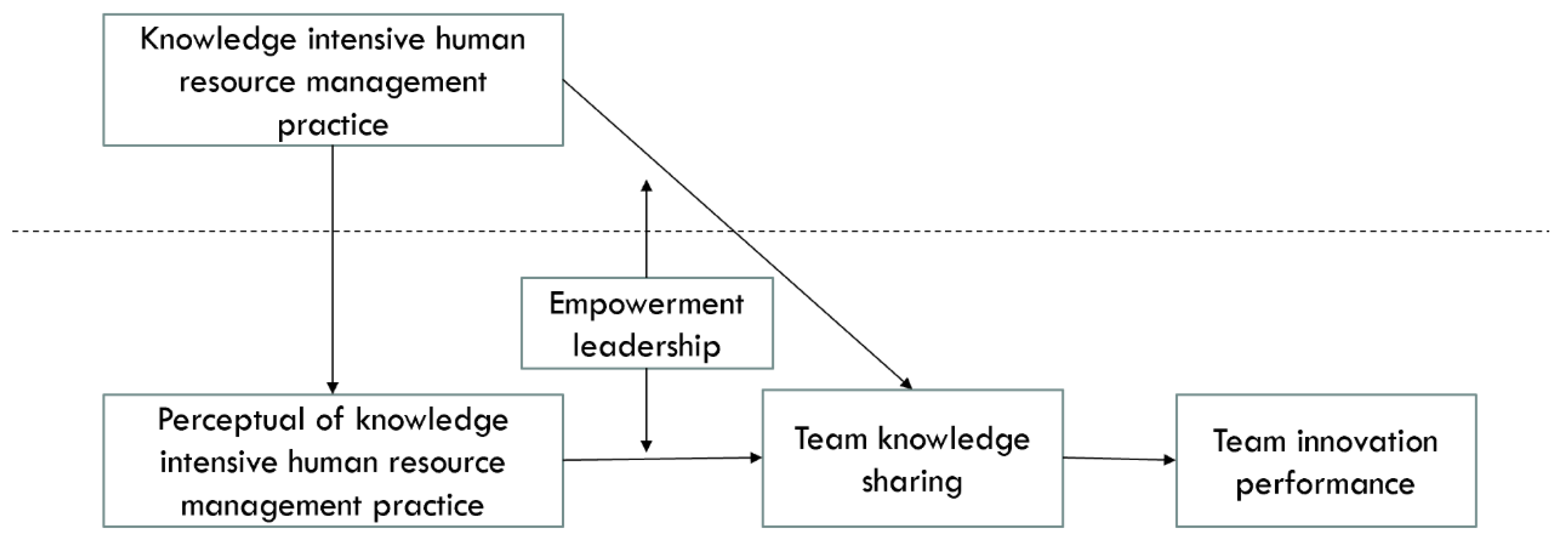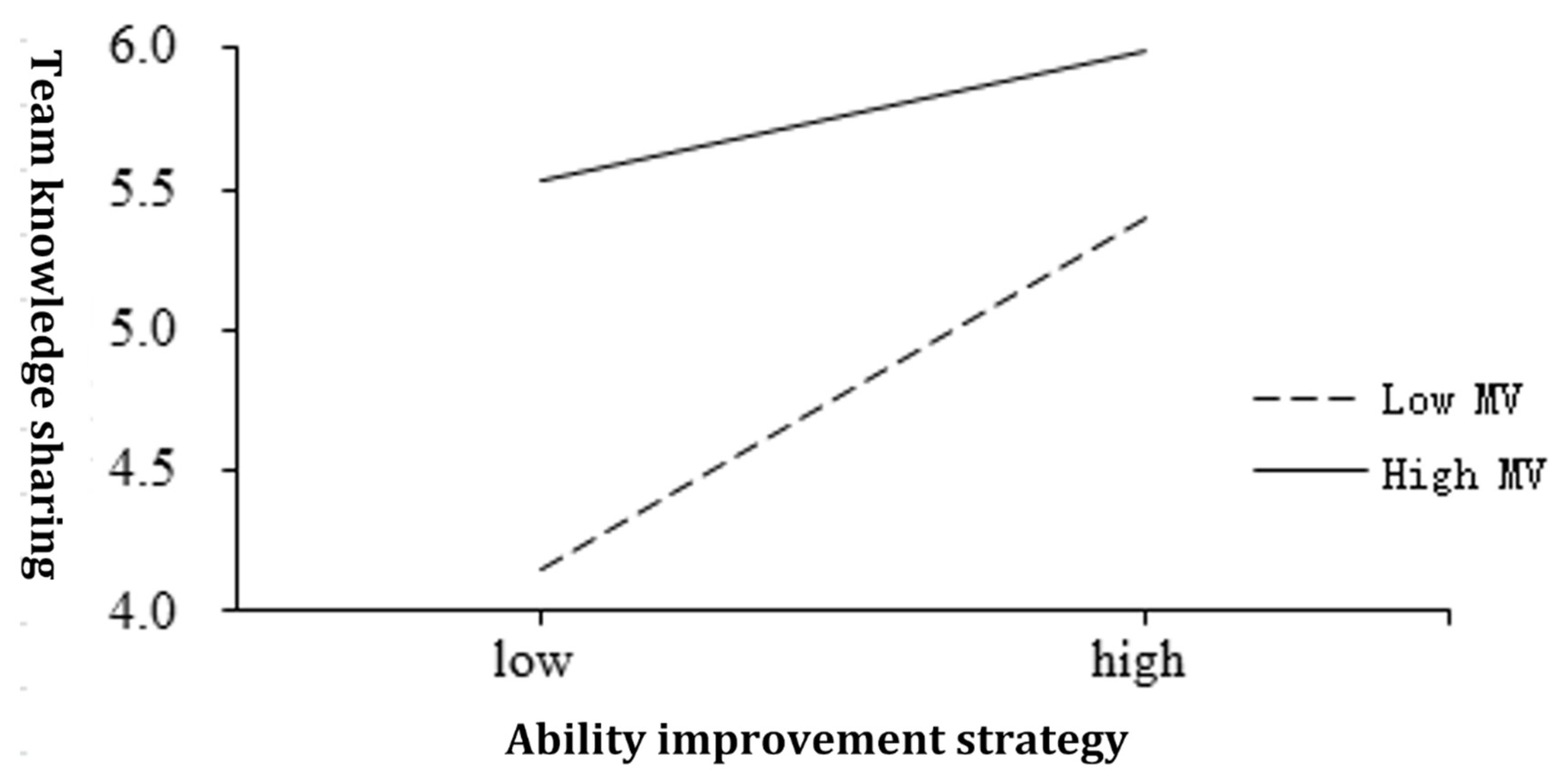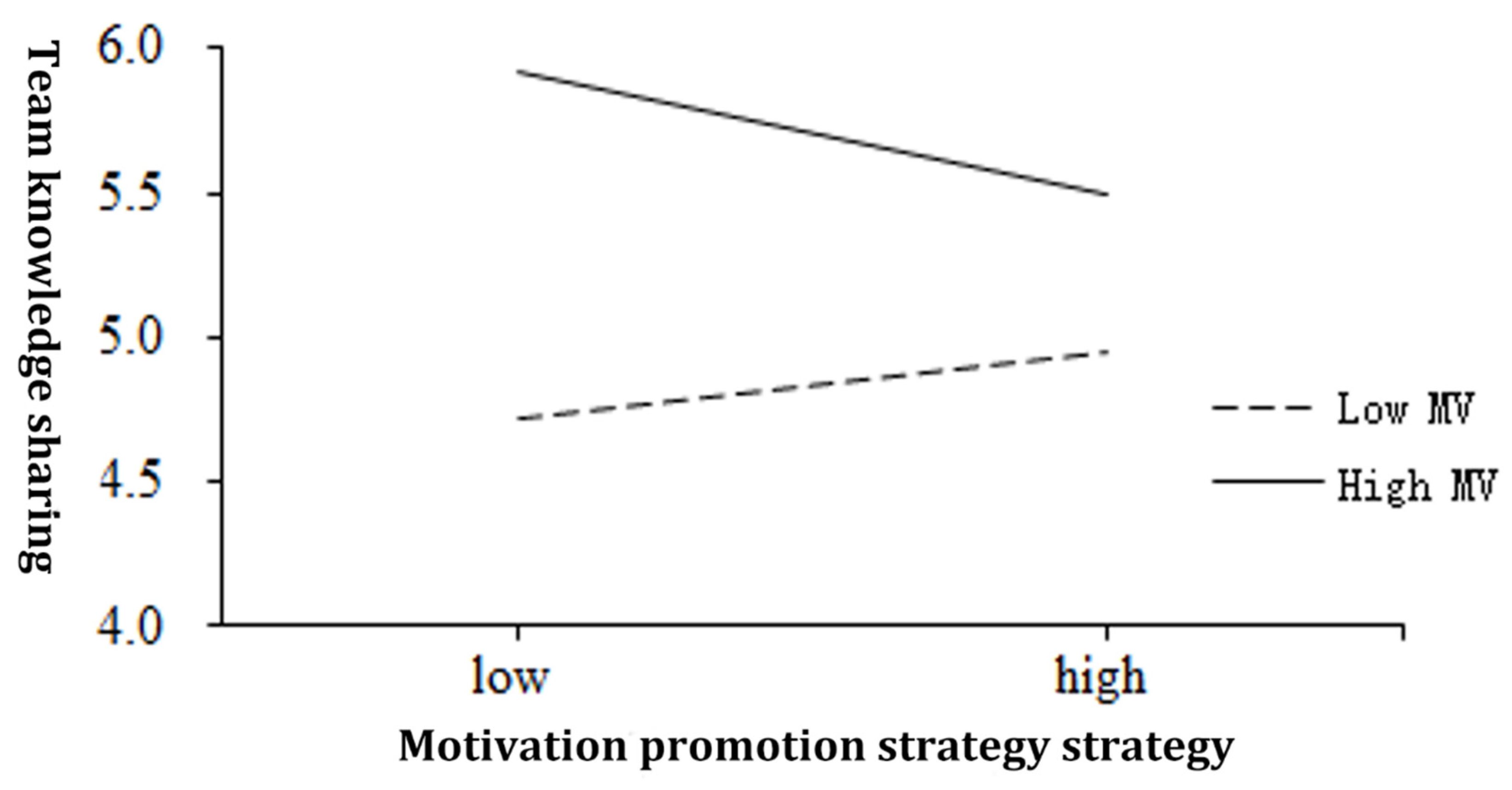Human Resource Practice Management for Knowledge Intensive Team: IMPACT on Team Innovation Performance and Substitution Effect of Empowerment Leadership
Abstract
1. Introduction
2. Theoretical Basis and Research Hypothesis
2.1. Leadership Substitutes Theory
2.2. Research Model
2.3. Research Hypothesis
2.3.1. Relationship between Human Resource Management Practice and Knowledge Sharing of Knowledge-Intensive Teams
2.3.2. Relationship between Human Resource Management Practice and Knowledge Sharing in Knowledge-Intensive Teams
3. Research Methods and Data Sources
3.1. Sample Selection
3.2. Measurement
4. Results
5. Conclusions
Author Contributions
Funding
Institutional Review Board Statement
Informed Consent Statement
Data Availability Statement
Conflicts of Interest
References
- Pellegrini, M.M.; Ciampi, F.; Marzi, G. The relationship between knowledge management and leadership: Mapping the field and providing future research avenues. Knowl. Manag. 2020. [Google Scholar] [CrossRef]
- Penalva, J. Innovation and Leadership as Design: A Methodology to Lead and Exceed an Ecological Approach in Higher Education. Knowl. Econ. 2021. [Google Scholar] [CrossRef]
- Yazdanmehr, E.; Ramezani, Y.; Aghdassi, F. Teacher Leadership and Conflict Management in EFL Classroom in the Light of the Contingency Theory of Human Resource Management: An Interdisciplinary Study. Theory Pract. Lang. Stud. 2020, 10, 916–927. [Google Scholar] [CrossRef]
- Collins, C. Expanding the resource based view model of strategic human resource management. Hum. Resour. Manag. 2021, 32, 331–358. [Google Scholar] [CrossRef]
- Lajoie, D.; Boudrias, S.; Rousseau, V. Value congruence and tenure as moderators of transformational leadership effects. Leadersh. Organ. Dev. J. 2017. [Google Scholar] [CrossRef]
- Kroon, B.; Van Woerkom, M.; Menting, C. Mindfulness as substitute for transformational leadership. Manag. Psychol. 2017, 32, 284–297. [Google Scholar] [CrossRef]
- Ma, X.; Iang, W. Transformational leadership, transactional leadership, and employee creativity in entrepreneurial firms. Appl. Behav. Sci. 2018, 54, 302–324. [Google Scholar] [CrossRef]
- Frieder, R.E.; Wang, G.; Oh, I.S. Linking job-relevant personality traits, transformational leadership, and job performance via perceived meaningfulness at work: A moderated mediation model. Appl. Psychol. 2018, 103, 324. [Google Scholar] [CrossRef]
- Koopman, J.; Scott, B.A.; Matta, F.K. Ethical leadership as a substitute for justice enactment: An information-processing perspective. Appl. Psychol. 2019, 104, 1103. [Google Scholar] [CrossRef]
- Chuang, P.; Chiu, S.F. When moral personality and moral ideology meet ethical leadership: A three-way interaction model. Ethics Behav. 2018, 28, 45–69. [Google Scholar] [CrossRef]
- Jon, P.H.; Peter, W.D. Leadership and Substitutes for Leadership Among Professional and Nonprofessional Workers. Appl. Behav. Science. 1986, 22, 29–46. [Google Scholar]
- Bass, B.M. From transactional to transformational leadership: Learning to share the vision. Organ. Din. 1990, 18, 19–31. [Google Scholar] [CrossRef]
- Jon, P.H. “Substitutes for leadership: Their meaning and measurement”—An historical assessment. Leadersh. Q. 1997, 8, 113–116. [Google Scholar]
- Portugal, E.; Yukl, G. Perspectives on environmental leadership. Leadersh. Q. 1994, 5, 271–276. [Google Scholar] [CrossRef]
- Francis, J.Y.; Shelley, D.; Jae, C.; Fred, D. Leadership and levels of analysis: A state-of-the-science review. Leadersh. Q. 2005, 16, 879–919. [Google Scholar]
- Shelley, D.; Francis, J.Y.; Jon, P.H.; Jennifer, V. Substitutes for leadership, or not. Leadersh. Q. 2004, 16, 169–193. [Google Scholar]
- Xie, H.T.; Zhang, P.W. The impact of transactional leadership on employee performance: The moderation effect of substitutes for leadership. Syst. Manag. 2015, 1, 21–28. [Google Scholar]
- Kingseed, C.C. Moving Tribute and a Primer on Leadership. Army 2008, 58, 108–109. [Google Scholar]
- John, M.J. “Substitutes for leadership: Their meaning and measurement”—Contextual recollections and current observations. Leadersh. Q. 1997, 8, 95–101. [Google Scholar]
- Kim, J.H. The substitution effect of leadership substitutes for transformational leadership in nursing organization. Taehan Kanho Hakhoe Chi. 2006, 36, 361–372. [Google Scholar] [CrossRef]
- Bennett, J.T. Abusive Supervision in Work Organizations: Review, Synthesis, and Research Agenda. J. Manag. 2007, 33, 261–289. [Google Scholar]
- Avolio, B.J.; Walumbwa, F.O.; Weber, T.J. Leadership: Current theories, research, and future directions. Annu. Rev. Psychol. 2009, 60, 421–449. [Google Scholar] [CrossRef] [PubMed]
- Wang, L.; Han, J.; Fisher, C.M.; Pan, Y. Learning to Share: Exploring Temporality in Shared Leadership and Team Learning. Small Group Res. 2017, 48, 165–189. [Google Scholar] [CrossRef]
- Li, X. Leaderrship Substitues and its Relationship with Transformational Leadership. Xiamen Univ. Technol. 2012, 20, 86–90. [Google Scholar]
- Kevin, K.; Nick, T.; Julian, B.; Catherine, L. Transformational leadership and employee psychological well-being. The mediating role of employee trust in leadership. Work Stress 2012, 26, 39–55. [Google Scholar]
- Robert, G.L.; Paola, G.; Susanna, L.M.C. Social-cognitive, relational, and identity-based approaches to leadership. Organ. Behav. Hum. Decis. Process. 2016, 136, 119–134. [Google Scholar]
- Steven, K.; John, M.J. Substitutes for leadership: Their meaning and measurement. Organ. Behav. Hum. Perform. 1978, 22, 375–403. [Google Scholar]
- Yin, K.; Xing, L.; Li, C.; Guo, Y. Are Empowered Employees More Proactive? The Contingency of How They Evaluate Their Leader. Front. Psychol. 2017, 8, 1802. [Google Scholar] [CrossRef]
- Lee, S.C.; Kim, H. The Effect of the Transactional Leadership and Transformational Leadership on Team Empowerment and Performance. Fash. Text. Res. 2008, 10, 936–946. [Google Scholar]
- Liu, Y. The review of empowerment leadership. Openj. Bus. Manag. 2015, 3, 476. [Google Scholar] [CrossRef]
- Amor, A.M.; Vázquez, P.A.; Faíña, A. Transformational leadership and work engagement: Exploring the mediating role of structural empowerment. Eur. Manag. 2020, 38, 169–178. [Google Scholar] [CrossRef]
- Al Harbi, J.A.; Alarifi, S.; Mosbah, A. Transformation leadership and creativity: Effects of employees pyschological empowerment and intrinsic motivation. Pers. Rev. 2019, 48, 1082–1099. [Google Scholar] [CrossRef]
- Adamovic, M.; Gahan, P.; Olsen, E. Bringing the leader back in: Why, how, and when leadership empowerment behavior shapes coworker conflict. Group Organ. Manag. 2020, 45, 599–636. [Google Scholar] [CrossRef]
- Shahzad, I.A.; Farrukh, M.; Ahmed, N.O.A. The role of transformational leadership style, organizational structure and job characteristics in developing psychological empowerment among banking professionals. J. Chin. Hum. Resour. Manag. 2018, 9, 107–122. [Google Scholar] [CrossRef]
- Knezovic, E.; Musrati, M.A. Empowering leadership, psychological empowerment and employees’ creativity: A gender perspective. Innov. Creat. Change 2018, 4, 51–72. [Google Scholar]
- Javed, B.; Abdullah, I.; Zaffar, M.A. Inclusive leadership and innovative work behavior: The role of psychological empowerment. Manag. Organ. 2019, 25, 554–571. [Google Scholar] [CrossRef]
- Leitão, J.; Pereira, D.; Gonçalves, Â. Quality of Work Life and Organizational Performance: Workers’ Feelings of Contributing, or Not, to the Organization’s Productivity. Environ. Res. Public Health 2019, 16, 3803. [Google Scholar] [CrossRef]
- Bian, X.; Sun, Y.; Zuo, Z. Transactional leadership and employee safety behavior: Impact of safety climate and psychological empowerment. Soc. Behav. Personal. 2019, 47, 1–9. [Google Scholar] [CrossRef]
- Kehoe, R.R.; Collins, C.J. Human resource management and unit performance in knowledge-intensive work. Appl. Psychol. 2017, 102, 1222. [Google Scholar] [CrossRef]
- Growe, A. Buzz at workplaces in knowledge-intensive service production: Spatial settings of temporary spatial proximity. Eur. Urban Reg. Stud. 2019, 26, 434–448. [Google Scholar] [CrossRef]
- Zhao, J.; Wu, G.; Xi, X. How collaborative innovation system in a knowledge-intensive competitive alliance evolves? An empirical study on China, Korea and Germany. Technol. Forecast. Soc. Change 2018, 137, 128–146. [Google Scholar] [CrossRef]
- Van De Mieroop, D.; Clifton, J.; Verhelst, A. Investigating the interplay between formal and informal leaders in a shared leadership configuration: A multimodal conversation analytical study. Hum. Relat. 2020, 73, 490–515. [Google Scholar] [CrossRef]
- Othman, S.; Mahmood, N. Linking employee engagement towards individual work performance through human resource management practice: From high potential employee’s perspectives. Manag. Sci. Lett. 2019, 9, 1083–1092. [Google Scholar] [CrossRef]
- Castellano, S.; Davidson, P.; Khelladi, I. Creativity techniques to enhance knowledge transfer within global virtual teams in the context of knowledge-intensive enterprises. Technol. Transf. 2017, 42, 253–266. [Google Scholar] [CrossRef]
- Zhang, W.; Sun, S.L.; Jiang, Y. Openness to experience and team creativity: Effects of knowledge sharing and transformational leadership. Creat. Res. J. 2019, 31, 62–73. [Google Scholar] [CrossRef]
- Beeck, S.O.; Wynen, H.A. HRM implementation by line managers: Explaining the discrepancy in HR-line perceptions of HR devolution. Hum. Resour. Manag. 2016, 27, 1901–1919. [Google Scholar]
- Mathieu, J.E.; Gallagher, P.T.; Domingo, M.A. Embracing complexity: Reviewing the past decade of team effectiveness research. Annu. Rev. Organ. Psychol. Organ. Behav. 2019, 6, 17–46. [Google Scholar] [CrossRef]
- Safrankova, A.N.A.M.; Mar, I. A new generation on the labour market and challenges faced by current human resource management practice. Ournal Social. Sci. 2018, 7, 95–111. [Google Scholar] [CrossRef]
- Kagel, J.H. Cooperation through communication: Teams and individuals in finitely repeated Prisoners’ dilemma games. Econ. Behav. Organ. 2018, 146, 55–64. [Google Scholar] [CrossRef]
- Gunawan, I.; Kusumaningrum, D.E.; Sumarsono, R.B. Investigation of Principal Leadership Based on Pesantren: Descriptive Study about Implementation of Human Resources Empowerment Models Based on Soft System Methodology. In Proceedings of the 4th International Conference on Education and Management (COEMA 2019), Malang, Indonesia, 25–26 October 2019; Atlantis Press: Paris, France, 2019; pp. 255–258. [Google Scholar]
- Jakubek, Y.A.; San Lucas, F.A.; Scheet, P. Directional allelic imbalance profiling and visualization from multi-sample data with RECUR. Bioinformatics 2019, 35, 2300–2302. [Google Scholar] [CrossRef] [PubMed]
- Sujatha, R.; Krishnaveni, R. Knowledge creating ba as a determinant of work performance of employees: An empirical analysis among pump manufacturing firms in South India. Asia Pac. Manag. Rev. 2018, 23, 45–52. [Google Scholar] [CrossRef]
- Phong, L.B.; Hui, L.; Son, T.T. How leadership and trust in leaders foster employees’ behavior toward knowledge sharing. Soc. Behav. Personal. 2018, 46, 705–720. [Google Scholar] [CrossRef]
- Yukl, G.A.; Van Fleet, D.D. Cross-situational, multimethod research on military leader effectiveness. Organ. Behav. Hum. Perform. 1982, 30, 87–108. [Google Scholar] [CrossRef]






| Team Knowledge Sharing | |||||
|---|---|---|---|---|---|
| Model 1 | Model 2 | Model 3 | Model 4 | Model 5 | |
| gender | −0.07 | −0.07 | −0.05 | −0.06 | −0.06 |
| age | −\10.00 | −\10.00 | 0.00 | 0.00 | 0.00 |
| education | 0.02 | 0.03 | 0.04 | 0.04 | 0.03 |
| working years | −\10.30 ** | −\10.30 ** | −\10.28 ** | −\10.28 ** | −\10.30 ** |
| ability improvement-type human resource management practice | 0.37 *** | 0.12 | |||
| motivational promotion-type human resource management practice | 0.54 *** | 0.44 *** | |||
| opportunity promotion-type human resource management practice | −\10.19 | −\10.05 | |||
| human resource management practice in knowledge-intensive team | 0.68 *** | ||||
| empowerment leadership | 0.43 *** | 0.43 *** | 0.42 *** | 0.45 *** | 0.40 *** |
| ability improvement-type human resource management practice×empowerment leadership | −\10.17 * | −\10.09 | |||
| motivational promotion-type human resource management practice×empowerment leadership | 0.15 | 0.10 | |||
| opportunity promotion-type human resource management practice×empowerment leadership | −\10.21 ** | −\10.20 ** | |||
| human resource management system×empowerment leadership | −\10.18 * | ||||
| Level 1σ2 | 0.83 | 0.83 | 0.82 | 0.81 | 0.83 |
| Deviance | 1387.25 | 1370.52 | 1399.48 | 1370.41 | 1388.71 |
| KMO Sample Measure | 0.93 | |
| Bartlett sphere test | Chi square | 3548.230 |
| df | 45 | |
| Sig. | 0.000 | |
| Item | Factor Loading | |
|---|---|---|
| Significance of work | I will help subordinates understand the relevance between my goals and the company’s goals. | 0.80 |
| I will help my subordinates realize the importance of their work to the overall situation. | 0.82 | |
| I will help my subordinates understand how to integrate their work into the overall situation. | 0.79 | |
| Promoting participation in Decision-making | I will help subordinates to participate in team decision-making. | 0.78 |
| I often discuss strategic decisions with my subordinates. | 0.81 | |
| Deliver performance Confidence | I believe that my subordinates can handle complicated work. | 0.78 |
| I believe that my subordinates can accomplish their tasks well. | 0.84 | |
| Provide autonomy | I allow my subordinates to do things in their own way. | 0.85 |
| I will keep the rules and regulations as simple as possible, so as to make the work of subordinates more efficient. | 0.83 | |
| I allow my subordinates to make decisions quickly in order to meet customer needs | 0.71 |
| Team Knowledge Sharing | |||||
|---|---|---|---|---|---|
| Model 6 | Model 7 | Model 8 | Model 9 | Model 10 | |
| gender | −0.07 | −0.04 | −0.08 | −0.07 | −0.07 |
| age | 0.00 | 0.00 | 0.00 | 0.00 | 0.00 |
| education | 0.05 | 0.05 | 0.07 | 0.07 | 0.05 |
| working years | −0.24 * | −0.28 ** | −0.29 ** | −0.24 ** | −0.27 ** |
| ability improvement-type human resource management practice perception | 0.33 *** | 0.23 *** | |||
| motivational promotion-type human resource management practice perception | −0.04 | −0.03 | |||
| opportunity promotion-type human resource management practice perception | 0.26 *** | 0.14 * | |||
| human resource management practice perception in knowledge-intensive team | 0.37 *** | ||||
| empowerment leadership | 0.30 *** | 0.38 *** | 0.27 *** | 0.26 ** | 0.29 *** |
| ability improvement-type human resource management practice perception×empowerment leadership | 0.03 | 0.07 | |||
| motivational promotion-type human resource management practice perception×empowerment leadership | −0.14 ** | −0.11 * | |||
| opportunity promotion-type human resource management practice perception×empowerment leadership | −0.03 | −0.05 | |||
| Human resource management system perception×empowerment leadership | −0.12 * | ||||
| Level 1σ2 | 0.75 | 0.82 | 0.79 | 0.73 | 0.79 |
| Deviance | 1364.83 | 1403.57 | 1388.29 | 1368.70 | 1390.14 |
Publisher’s Note: MDPI stays neutral with regard to jurisdictional claims in published maps and institutional affiliations. |
© 2021 by the authors. Licensee MDPI, Basel, Switzerland. This article is an open access article distributed under the terms and conditions of the Creative Commons Attribution (CC BY) license (https://creativecommons.org/licenses/by/4.0/).
Share and Cite
Han, Z.; Ren, H.; Yang, S.; Han, Y. Human Resource Practice Management for Knowledge Intensive Team: IMPACT on Team Innovation Performance and Substitution Effect of Empowerment Leadership. Sustainability 2021, 13, 4801. https://doi.org/10.3390/su13094801
Han Z, Ren H, Yang S, Han Y. Human Resource Practice Management for Knowledge Intensive Team: IMPACT on Team Innovation Performance and Substitution Effect of Empowerment Leadership. Sustainability. 2021; 13(9):4801. https://doi.org/10.3390/su13094801
Chicago/Turabian StyleHan, Zhen, Hao Ren, Shiyu Yang, and Yuhang Han. 2021. "Human Resource Practice Management for Knowledge Intensive Team: IMPACT on Team Innovation Performance and Substitution Effect of Empowerment Leadership" Sustainability 13, no. 9: 4801. https://doi.org/10.3390/su13094801
APA StyleHan, Z., Ren, H., Yang, S., & Han, Y. (2021). Human Resource Practice Management for Knowledge Intensive Team: IMPACT on Team Innovation Performance and Substitution Effect of Empowerment Leadership. Sustainability, 13(9), 4801. https://doi.org/10.3390/su13094801





